IMEHA (International Model Equine Hobbyists Association) was an online photo showing site that existing until 2018. Included on the site were these guidebooks for judging and showing model horses in Performance classes. MEPSA has obtained permission to share the info contained in the guides.
Test of Freestyle Kur
The Quadrille
An additional section of competition dressage called the “Quadrille” are provided by the USDF for five levels of dressage performance of groups of horses, typically four, sometimes 6 horses, less often 8 in even number only. The teams of riders perform COMPULSORY TESTS, with or without optional music. IMEHA Quadrille entries have the additional option of performing a MUSICAL FREESTYLE KUR routine of their choice, which may involve any dressage movements.
Groups are judged on the spacing (longitudinal and lateral), synchrony (timing of turns, circles and transitions, cross-over’s and pass-through’s), impulsion, submission (obedience to the aids in order to perform patterns accurately), as well as their performance as a group (uniformity and harmonious).
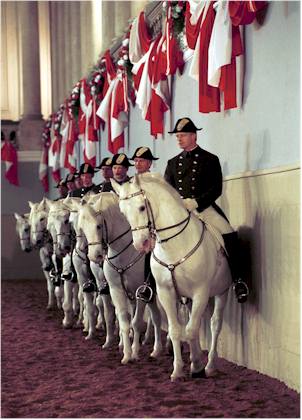 The Shoulder-in | 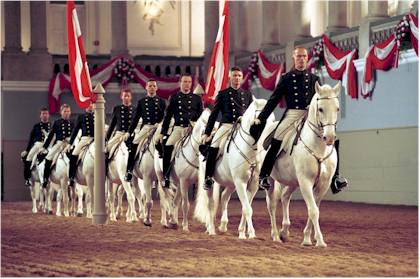 The Salute at Collected Walk |
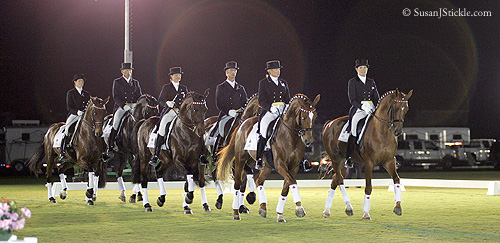
USDF UADRILLE COMPULSORY TESTS – The Five Competitive Levels:
Basic Level Objective:
To introduce the quadrille team to competition. Test is to be performed at walk and trot only, in a calm, obedient manner.
Training Level Objective:
To exhibit movements and transitions at walk, trot, and canter. Horses should move energetically forward at an even tempo and accept the riders’ aids.
First Level Objective:
To perform with increased quality of impulsion, submission, and performance as a team.
Second Level Objective:
To exhibit Second Level movements and more complex quadrille formations at the walk, trot, and canter. Horses should be calm, obedient, moving freely and rhythmically forward, and be stretched into the bit. Team should maintain even spacing and perform movements in a uniform manner.
Third Level Objective:
To exhibit Third Level movements and more complex quadrille formations with the impulsion and submission necessary for harmony and team cohesion.
The Quadrille Entry Requirements:
Required Tack:
An English (Huntseat) saddle or a Dressage saddle is required based on the specific test level depicted (Huntseat or Dressage saddle for 1st or 2nd, Dressage saddle for levels above 2nd).
A Snaffle Bridle with cavesson noseband, dropped noseband, flash noseband, or combination of flash and dropped nosebands (can be padded) OR a Double Bridle with bridoon and curb with curb chain is required based on the specific test level depicted (Snaffle bridle for 1st or 2nd, Snaffle or double bridle for 3rd or 4th, Double bridle for levels above 4th.)
Optional Equipment:
White or conservative-color Saddle pads
Breastplate or crupper (4th level and lower)
Spurs without rowels
Leg wraps or bandages (if used, must be worn by all horses competing)
Whips (need not be carried by all riders)
Prohibited Equipment:
Pelham bits, martingales, bit guards, blinkers, or other gadgets are strictly forbidden, under penalty of elimination. Snaffle bridles are prohibited for levels above 4th.
Rider Attire for COMPULSORY TESTS or MUSICAL FREESTYLE:
Riders should be in tasteful, matching outfits. Riding coats are optional.
Riders should wear approved protective head gear.
Entry Requirements:
Test
A dressage arena (indoor or outdoor) and visible letter and description of the test and movement
Musical Freestyle Kur
An arena (indoor or outdoor) and description of level and movement.
The name of the music if Musical Freestyle.
4, 6 or 8 horses in the entry.
The Pas de Deux
The Pas de Deux (ride of two) combines the elegance of dressage set to music with the added complexity of two horses performing together. Either a choreographed MUSICAL FREESTYLE or a standard COMPULSORY TEST can be ridden to music. (Music is mandatory.) In Pas de Deux compulsory tests or musical freestyle there are required movements and figures that must be performed at the specific level of dressage being shown. Pas de deux may be offered at any level. Both horses and riders must be secure and competent in the execution of the technical requirements for the level they choose to show. The better their command of these elements the more successful they will be with their final scores.
Pas de Deux performances are judged according to the technical execution (performance as a pair, required elements, impulsion and submission), and the artistic impression (choreography, harmony between horses and riders, and musicality).
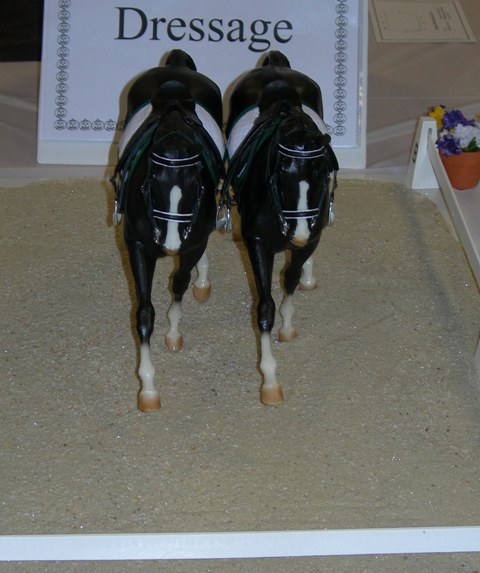 Pas de Deux down the Quarter Line, Medium Trot | 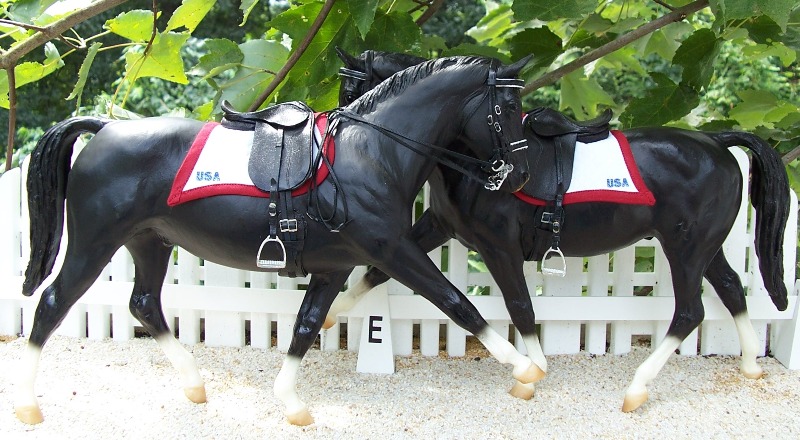 Pas de Deux passing at E, Medium Trot | 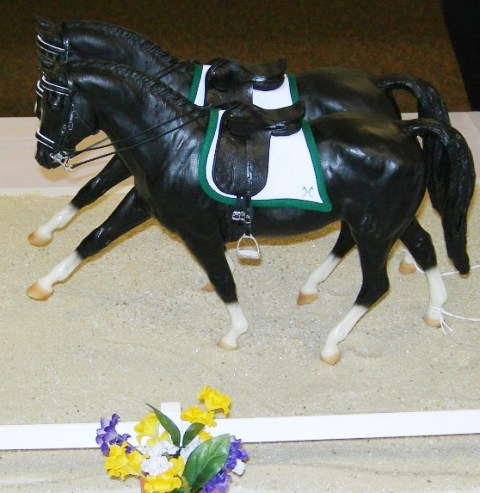 Pas de Deux down the Quarter Line, Medium Trot |
The Pas de Deux Dressage Movements:
MUSICAL FREESTYLE or COMPULSORY TEST entries must indicate the level and movement being performed. — Following is a list of dressage movements (and some combinations and transitions) specifically permitted and forbidden at each level.
TRAINING LEVEL:
Clearly Forbidden:
Any lateral work, counter-canter, simple changes, flying changes, rein back, turn-on-haunches or pirouette at walk or canter, piaffe, passage.
Clearly Allowed:
Anything not clearly forbidden, 20-meter circle or smaller at trot, 20-meter circle or smaller at canter.
FIRST LEVEL:
Clearly Forbidden:
Rein back, shoulder-in, travers, renvers, half-pass, flying changes, turn-on-haunches or pirouette at walk or canter, piaffe, passage.
Clearly Allowed:
Counter-canter (any configuration), zig-zag leg-yield, leg-yield along wall (like shoulder-in), lengthen trot or canter on 20- meter circle, canter serpentine, simple change, walk-canter-walk, halt-canter-halt, 10-meter circle or smaller at trot, 15-meter circle or smaller at canter, all figures including circles regardless of size.
SECOND LEVEL:
Clearly Forbidden:
Half-pass, flying changes, pirouette at canter, piaffe, passage.
Clearly Allowed:
Full and double turn-on-haunches, renvers, travers, medium canter and trot on 20-meter circle, medium canter on diagonal, halt-canter-halt, 10-meter circle or smaller at canter.
THIRD LEVEL:
Clearly Forbidden:
Tempi changes (4s, 3s, 2s, 1s) pirouette at canter, piaffe, passage.
Clearly Allowed:
Everything that is not clearly forbidden, including: half-pass zig-zag in trot, half-pass zig-zag in canter with flying changes, full and double walk pirouettes.
FOURTH LEVEL:
Clearly Forbidden:
Full pirouette at canter, tempi changes (2s, and 1s), piaffe, passage.
Clearly Allowed:
Everything that is not clearly forbidden.
FEI:
Follow FEI Prix St. Georges for Young Riders, Intermediate I, and Grand Prix freestyle score sheets for what is forbidden and allowed.
The Pas de Deux Entry Requirements:
Required Tack:
An English (Huntseat) saddle or a Dressage saddle is required based on the specific test level depicted (Huntseat or Dressage saddle for 1st or 2nd, Dressage saddle for levels above 2nd).
A Snaffle Bridle with cavesson noseband, dropped noseband, flash noseband, or combination of flash and dropped nosebands (can be padded) OR a Double Bridle with bridoon and curb with curb chain is required based on the specific test level depicted (Snaffle bridle for 1st or 2nd, Snaffle or double bridle for 3rd or 4th, Double bridle for levels above 4th.)
Optional Equipment:
White or conservative-color Saddle pads
Breastplate or crupper (4th level and lower)
Spurs without rowels (4th level and lower — spurs are required above 4th level)
Leg wraps
Whips
Prohibited Equipment:
Pelham bits, martingales, bit guards, blinkers, or other gadgets are strictly forbidden, under penalty of elimination. Snaffle bridles are prohibited for levels above 4th.
Rider Attire:
COMPULSORY TESTS:
The attire required is based on the test level depicted. For levels up to 4th, the dress code is a short (huntseat) riding coat of dark color, with tie, choker or stock tie, white or light-colored breeches or jodhpurs, boots or jodhpur boots, a hunt cap or riding hat with a hard shell. A Shadbelly, tailed coat with Top Hat is permitted for 4th level. For levels above 4th the dress code is Shadbelly, tail coat of black or dark blue color, with tie, choker or stock tie white, off-white, or same color as coat, white or light-colored breeches or jodhpurs, black boots or jodhpur boots, and a Top Hat that is black or the same color as the coat. Men may also wear a short coat with a bowler hat. Gloves of white, off-white or same color as the coat are required. Spurs without rowels are compulsory.
MUSICAL FREESTYLE:
Riders may wear EITHER dressage attire appropriate for the level performed (as stated above) OR COSTUMES.
Entry Requirements:
Test
A dressage arena (indoor or outdoor) and visible letter and description of the test and movement
Musical Freestyle Kur
An arena (indoor or outdoor) and description of level and movement.
The name of the music
2 horses in the entry.
Compulsory Tests for Levels 1st – 4th
Link to USDF competition dressage “Pas de Deux” training through grand prix levels, test core sheet/requirements: https://www.usdf.org/education/other-programs/pasdedeux/index.asp
DRESSAGE ENTRANTS PLEASE NOTE:
The above list of Tack and Attire requirements is merely a simplified version.
FOR COMPLETE RULES, DETAILS AND SPECIFICS please see Dressage Main Page, Dressage Overview,
Dressage – the Value of Knowledge, the USEF Dressage Rulebook, FEI Rulebook and the USDF Rulebook listed above in the top menu.
Pas de Deux and Quadrille Premium Requirements:
A Quadrille Entry must depict 4, 6, or 8 horses (and riders if used) in the image. Horses need not be identical, but additional credit will be given if matched.
A Pas de Deux Entry must depict 2 horses (and riders if used) in the image. Horses need not be identical, but additional credit will be given if matched.
The entry should be for ONE HORSE’S name, and the description should indicate which horse is to be judged. If more than one horse is to be judged, a different photograph must be entered for each horse. The same photograph may not be entered for multiple horses.
